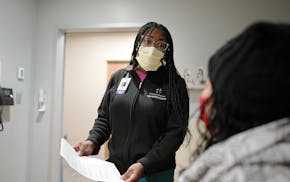A few observations about a good year in Minnesota business, as the national economy slows in this 10th year of recovery.
• The Minnesota economy continues to grow modestly. A record number of Minnesotans are at work. Wages are rising. Small business starts are positive, and the state projects a $1.5 billion budget surplus for the 2019-2020 biennium.
• We also should be concerned. Minnesota's economic growth of less than 2 percent is hamstrung by too few workers to meet the demand of employers as baby boomers retire and businesses continue to expand, albeit modestly. The long-term trends are positive, but the national economy may slide into recession, thanks partly to trade wars, contradictory policies and financial-market dives since summer.
Minnesota exports were up 8 percent to $23 billion in 2017. However, the trend is softening. And farmers are stuck with commodities they can't sell to China. Business angst is growing.
• We're leading in clean energy. Minnesota has proved we can grow while using less juice, and cut pollution, including greenhouse gases.
Minnesota once imported almost all its energy, including coal, oil and gas to power its fleet, buildings and utilities. Now, the state boasts a growing renewable sector, including biofuels. We generate a quarter of our electricity from renewables. We have created thousands of jobs in wind, solar and related technologies.
The state's largest utilities, prompted by the Next Generation Energy Act of 2007, already are surpassing the goal of 25 percent renewable energy by 2025. Xcel Energy, the nation's biggest utility provider of economical wind energy, has a goal of producing 85 percent of its energy carbon-free by 2030.
Homegrown outfits such as IPS Solar of Roseville, founded in 1991, also have seen a boost.
IPS has grown from seven to 40 employees since 2014, and it has employed hundreds of contract workers over the same time period.
• Workforce development and immigration. The rate of growth among people of color in the Twin Cities workforce, particularly in good-paying jobs such as technology and business and professional services has as much as doubled that of the growth in the overall labor market since the Great Recession. That's important because the minority population, including blacks and Latinos, is growing faster than the white population.
Moreover, we need to continue to narrow the education and income gaps that plague minority populations, including through remedial education, apprenticeships and some of the highly effective, employer-based training programs in partnership with chambers of commerce, high schools and community colleges.
Organizations such as Twin Cities Rise, the Neighborhood Development Center, Summit Academy, Project for Pride in Living, MEDA, Prime Digital Academy, the IT-Ready training program of the computer industry, the Community Reinvestment Fund and some local banks are helping to train, equip and finance a diverse wave of trained workers and entrepreneurs in finance, construction, technology and other industries.
Javier Martinez is an important part of a fast-growing piece of the Twin Cities labor force and a critical element in our economic future. Martinez, 27, who emigrated from Mexico as a child, delivered newspapers and cleaned houses after graduating St. Paul Johnson High School.
He also was pretty good with computers. Today, he is a certified IT professional at a small business in northeast Minneapolis. He graduated in 2014 from the IT-Ready training program that targets nontraditional IT students who have demonstrated aptitude and interest but lack a computer science background. Martinez doubled his income over a couple of years. Martinez and his wife own a house in St. Paul and are raising two children.
• Thanks partly to business support in recent years, more Minnesota children are ready for kindergarten. But not enough. And Minneapolis Federal Reserve Bank research going back 15 years by economist Art Rolnick and others shows the 40 percent-plus of kids who aren't ready for kindergarten have a higher incidence of dropping out of school, teen pregnancy and juvenile delinquency. Investing $1 in quality preschool for at-risk, mostly low-income families yields up to a $16 return to the public in higher wages and taxes and lower public safety expenses over the lifetime of these kids.
The alternative to this investment often is prison at $40,000 a year, particularly for male dropouts. And we don't need to institute pre-K in every school for everybody, as the education lobby insists.
Rolnick and attorney Mike Ciresi, another 20-year volunteer and funder on this issue, have come up with a pretty good compromise that would increase the support for low-income families.
• We need common-sense immigration reform that grants citizenship to children born to undocumented immigrants and which offers, as Ronald Reagan and both Bush presidents did, a pathway to citizenship to those who invest time and money to become U.S. citizens.
Neal St. Anthony has been a Star Tribune business columnist and reporter since 1984. He can be contacted at nstanthony@startribune.com.

St. Anthony: 'Patient' investing paying off for St. Paul's Hill Capital

Jennifer Smith, leader of Burnsville's Innovative Office Solutions, has died

St. Anthony: Medical professions in Minnesota need more people of color in their ranks



